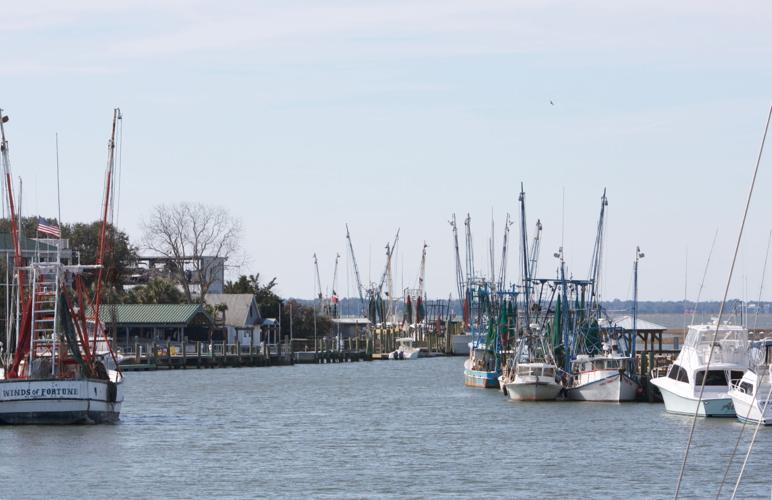Shem Creek is often called Mount Pleasant's crown jewel. It also gets crowded, doesn't have enough parking, and lacks needed infrastructure for the commercial fishermen so important to the creek as it's known today.
Those are among the conclusions laid out in reports from two groups who have worked to ask the people most invested in the creek and the surrounding area what issues it faces. And, they both recently released a catalog of those issues to the public. Neither effort has come up with answers yet for how to preserve the character and vibrant mix of uses that define the creek, so their work is not done.
The South Carolina Sea Grant Consortium conducted a study of five of the state’s working waterfronts, Shem Creek among them. The goal of the study was not necessarily to provide communities with all the answers but to help them articulate the issues they faced, give that information back to the community, and help them explore what they can do about it.
The other effort came from the Town of Mount Pleasant, which chartered the Shem Creek Task Force. That group of residents, business owners and other people with ties to the creek was appointed by Mount Pleasant Mayor Linda Page and met six times for a few hours at a time to discuss the issues facing the landmark. In the end it recommended that council hire a consultant to develop a master plan for the creek area.
“We identified a whole lot of issues that we have with it, and we identified a lot of things we’d like to see,” said Task Force member Miles Martschink. “But none of us are planners, and that’s what we need.”
On Monday, the Town of Mount Pleasant Bids and Purchases Committee approved $50,000 to hire a consultant for 90 days to work with members of the Task Force. The consultant will be tasked to collect data and information and produce a master plan for the Shem Creek area. Mount Pleasant Town Council approved the mid-year budget adjustment at its annual council retreat earlier this month.
Both Sea Grant and the Task Force reached similar conclusions about the most pressing issues for the creek.
One is better control of traffic in the water. In the Task Force’s final report, that group says, “Activity levels in the creek are at a seemingly all-time high,” but there isn’t enough knowledge of boater rules and safety to go along with it. Another is parking, not just for those who come to enjoy the creek, but also for those who work there.
Another reoccurring theme was the need to take steps to ensure that Shem Creek stays a working waterfront, with a vibrant commercial seafood industry. Both groups singled out infrastructure needs including dock space, places to unload product and cold storage. Sea Grant’s focus group also underscored uncertainty about whether there will be future generations of fishermen to carry on the work. And the Task Force said the local industry needs more support from the community. Some people eat shrimp from other places without realizing it's not local, their report says.
The Task Force also raised questions about the buildings on and near the creek and how they contribute to the creek’s character. They pointed to things like having a variety of design styles as opposed to something like a series of flat roofs, keeping properties on or near the creek maritime business-related, and giving leeway to existing buildings that are not up to flood regulations so that if they get so wrecked by a future storm and have to rebuild, the cost of repairs doesn't put them out of business.
Both the Sea Grant study and the Task Force came together because Shem Creek and other communities with working waterfronts feel the pressures of growth and change and wonder how their landmarks of cultural industry will fare.
“We pulled this together because we had heard from community members and other constituents that there was a need for information,” said April Turner, coastal community specialist with Sea Grant, at a public forum at Mount Pleasant Regional Library last Tuesday.
Similarly, the final report of the Shem Creek Task Force, released last month, begins: “Shem Creek is the iconic landmark of the Town of Mount Pleasant. Its history as a community cornerstone and economic driver continues presently, and with the growth occurring in Mount Pleasant, it is important to preserve this area for future generations.”
The purpose of Sea Grant’s public forum was as much to communicate to the community what it found as it was to solicit feedback on what more the public wants to know and what to do next. The crowd of about 50 people packed into the room for the forum included a cross-section of residents, business owners, government officials and members of the Shem Creek Task Force.
For the study, the agency conducted focus groups in 2015 with a similar group of people invested in the five working waterfronts, including Shem Creek, they looked at. The backgrounds of those in the focus groups ranged from shrimping to restaurants to government and residents. At Shem Creek, they also conducted five interviews with other stakeholders as part of the study.
While Shem Creek faces a unique mix of pressures today, the waterway is no stranger to change. In fact, the commercial fishing industry is a fairly recent addition.
For most of its history, Shem Creek was an industrial place, home to ship builders, brick, tile and bucket makers, and even the first water-driven combined rice and saw mill, according to local historian Suzannah Smith Miles. She says it wasn’t until the 1930s that Captain William C. Magwood first began trawling for shrimp in the creek.


